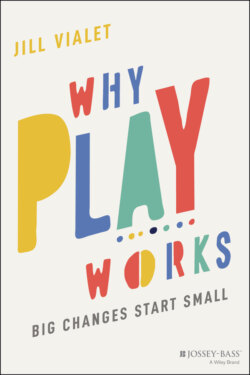Читать книгу Why Play Works - Jill Vialet - Страница 15
Defining Play
ОглавлениеBut why the shift from sports to play? Sports hold a funny place in American life. Although many people in the US love sports, there is a not‐insignificant population that see sports as somewhat suspect. Some of these humans work in schools, and they would argue that they have been driven to this position by the extreme way we push young people into sports. They see sports as competition for the time and attention of their students and a distraction from the “real” work of teaching and learning.
Play and sports, although deeply connected, aren't exactly the same. Usually in sports your goal is trying to win. And that really does change everything. One of my favorite definitions of a game comes from the philosopher Bernard Suits, who explains a game as the “voluntary attempt to overcome unnecessary obstacles.”1 Fundamentally, there is an attitudinal difference between having an end goal or not. It's not that play isn't serious and sports are—play can be extraordinarily serious. It's not that play is always fun, either. People often think of play as the opposite of work, but as the New Zealand play theorist Brian Sutton‐Smith wrote, “The opposite of play is not work. The opposite of play is depression.”2 The difference is really in the fundamental question, “to what end?”
Defining play is a tricky thing to do. It's a little like the old saying about pornography, “you know it when you see it.” Play theorists have debated the definition for as long as there have been play theorists. In his 1955 book Homo Ludens, Johan Huizinga defined play as “a free activity standing quite consciously outside ‘ordinary’ life … ‘not serious,’ but at the same time absorbing the player intensely and utterly.”3 Developmental psychologist Lev Vygotsky limited his discussion of play to the make‐believe play of preschoolers, and Maria Montessori maintained that play was the work of a child, emphasizing the importance of play based in reality.4
Mildred Parten proposed a system of classification for play in the 1930s that is still commonly used in child development. Her system was originally made up of six categories: unoccupied play, onlooker behavior, solitary independent play, parallel play, associative play, and cooperative play. Subsequent sociologists have added five additional categories: dramatic/fantasy play, competitive play, symbolic play, physical play, and constructive play.5
More recently, Dr. Stuart Brown's book, Play: How It Shapes the Brain, Opens the Imagination, and Invigorates the Soul, takes a stab at defining the activity, laying out the essence of play in seven properties: purposeless, voluntary, inherent attraction, freedom from time, diminished consciousness of self, improvisational potential, and continuation desire.6 Like everything else in play theory, these seven properties have been debated extensively. Is play marked by purposelessness or the absence of apparent purpose? Can you be forced to play? If you are extrinsically motivated, does that diminish the value of play? What about when play stops being fun?
The one thing that all the play theorists seem to agree on is the importance of play being voluntary. This emphasis on choice also feels like the characteristic that has the greatest influence on the experience of play in schools, providing students with a direct understanding of the difference between engagement and compliance. As a result, play can be a source of uneasiness for adults who see their job as maintaining control, even as it offers a powerful springboard for encouraging students to be the drivers of their own education.
In an interview with the American Journal of Play, Dr. Brown offered a wonderful definition: “Play is an ancient, voluntary, inherently pleasurable, apparently purposeless activity or process that is undertaken for its own sake and that strengthens our muscles and our social skills, fertilizes brain activity, tempers and deepens our emotions, takes us out of time, and enables a state of balance and poise.”7 He goes on to emphasize the importance of play being voluntary, suggesting that when an activity becomes compulsive—or an addiction—it can no longer be play because you are no longer really choosing it. “When play ceases to be voluntary, it ceases to be play.”
